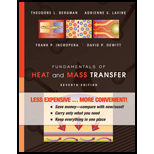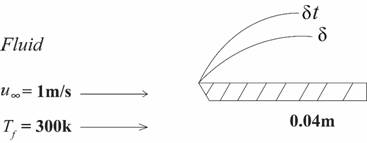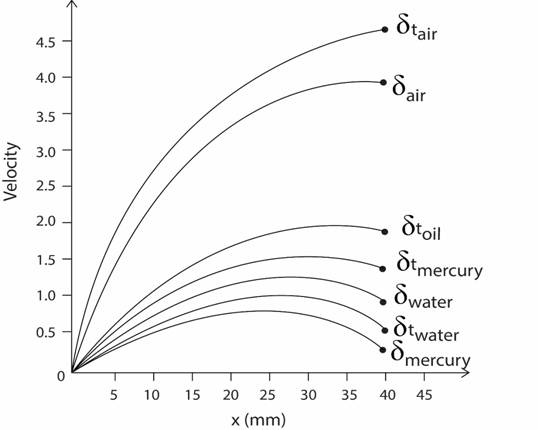
Consider the following fluids at a film temperature of 300 K in parallel flow over a flat plate with velocity of 1 m/s: atmospheric air, water, engine oil, and mercury.
- For each fluid, determine the velocity and thermal boundary layer thicknesses at a distance of 40 mm from the leading edge.
- For each of the prescribed fluids and on the same coordinates, plot the boundary layer thicknesses as a function of distance from the leading edge to a plate length of 40 mm.
(a)
The velocity and thermal boundary layer thickness at a distance of
Answer to Problem 7.1P
The thermal boundary layer thickness for air, water, oil and mercury is 4.48, 0.52, 1.27, and 1.17 respectively.
Explanation of Solution
Given Information:
Properties of air at
Properties of water at
Properties of engine oil at
Properties of mercury at
Concept used:
The equation of Reynolds number is
The formula for nusselt number is
The formula for average nusselt number is
The formula of laminar
Nusselt number:
It is the ratio of convective heat transfer to convective heat transfer across a boundary.
Where
Calculation:
Know that the equation of Reynolds number.
From the figure:

Put
Put
Know that the formula of laminar
Put
Convert the unit of laminar
Know that the formula of laminar
Put
Put
Know that the formula of laminar
Put
Know that the formula of laminar
Put
Put
Know that the formula of laminar
Put
Know that the formula of laminar
Put
Put
Know that the formula of laminar
Put
Know that the formula of laminar
Put
Conclusion:
Hence, the thermal boundary layer thickness for air, water, oil and mercury is 4.48, 0.52, 1.27, and 1.17 respectively.
b)
To draw: the boundary layer thickness from the leading edge to a plate length of
Answer to Problem 7.1P
Created the graph for determined values of thermal boundary layer thickness for air, water, oil and mercury is 4.48, 0.52, 1.27, and 1.17 respectively with the values oflaminar thermal boundary layer
Explanation of Solution
Given Information:
The thermal boundary layer thickness for air, water, oil and mercury is 4.48, 0.52, 1.27, and 1.17 respectively.
Entire length
Boundary layer
Concept used:
Plot the graph by Matlab software, obtained values by formulas correlation between Reynolds equation, Nusselt number, average nusselt number and boundary layer thickness.
Calculation:
Know that the determined values of thermal boundary layer thickness for air, water, oil, mercury are 4.48, 0.52, 1.27, and 1.17 respectively and determined values of the laminar thermal boundary layer are
Substitute the values of thermal boundary layer thickness and laminar thermal boundary on the graph.

Conclusion:
Created the graph for determined values of thermal boundary layer thickness for air, water, oil and mercury is 4.48, 0.52, 1.27, and 1.17 respectively with the values oflaminar thermal boundary layer
Want to see more full solutions like this?
Chapter 7 Solutions
Fundamentals of Heat and Mass Transfer
- Test for exactness. If exact, solve. If not, use an integrating factor as given or obtained by inspection or by the theorems in the text. a. 2xydx+x²dy = 0 b. (x2+y2)dx-2xydy = 0 c. 6xydx+5(y + x2)dy = 0arrow_forwardNewton's law of cooling. A thermometer, reading 5°C, is brought into a room whose temperature is 22°C. One minute later the thermometer reading is 12°C. How long does it take until the reading is practically 22°C, say, 21.9°C?arrow_forwardSolve a. y' + 2xy = ex-x² b. y' + y sin x = ecosx, y(0) = −1 y(0) = −2.5arrow_forward
- = MMB 241 Tutorial 3.pdf 2/6 90% + + 5. The boat is traveling along the circular path with a speed of v = (0.0625t²) m/s, where t is in seconds. Determine the magnitude of its acceleration when t = 10 s. 40 m v = 0.0625² 6. If the motorcycle has a deceleration of at = (0.001s) m/s² and its speed at position A is 25 m/s, determine the magnitude of its acceleration when it passes point B. .A 90° 300 m n B 2arrow_forward= MMB 241 Tutorial 3.pdf 4/6 67% + 9. The car is traveling along the road with a speed of v = (2 s) m/s, where s is in meters. Determine the magnitude of its acceleration when s = 10 m. v = (2s) m/s 50 m 10. The platform is rotating about the vertical axis such that at any instant its angular position is u = (4t 3/2) rad, where t is in seconds. A ball rolls outward along the radial groove so that its position is r = (0.1+³) m, where t is in seconds. Determine the magnitudes of the velocity and acceleration of the ball when t = 1.5s.arrow_forwardThe population of a certain country is known to increase at a rate proportional to the number of people presently living in the country. If after two years the population has doubled, and after three years the population is 20,000, estimate the number of people initially living in the country.arrow_forward
- = MMB 241 Tutorial 3.pdf 6/6 100% + | 日 13. The slotted link is pinned at O, and as a result of the constant angular velocity *= 3 rad/s it drives the peg P for a short distance along the spiral guide r = (0.40) m, where 0 is in radians. Determine the radial and transverse components of the velocity and acceleration of P at the instant = 1/3 rad. 0.5 m P r = 0.40 =3 rad/sarrow_forward= MMB 241 Tutorial 3.pdf 1/6 90% + DYNAMICS OF PARTICLES (MMB 241) Tutorial 3 Topic: Kinematics of Particles:- Path and Polar coordinate systems and general curvilinear QUESTIONS motion. 1. Determine the acceleration at s = 2 m if v = (2 s) m/s², where s is in meters. At s = 0, v = 1 m/s. 3 m 2. Determine the acceleration when t=1s if v = (4t2+2) m/s, where t is in seconds. v=(4²+2) m/s 6 marrow_forward5.112 A mounting bracket for electronic components is formed from sheet metal with a uniform thickness. Locate the center of gravity of the bracket. 0.75 in. 3 in. ༧ Fig. P5.112 1.25 in. 0.75 in. y r = 0.625 in. 2.5 in. 1 in. 6 in. xarrow_forward
- 4-105. Replace the force system acting on the beam by an equivalent resultant force and couple moment at point B. A 30 in. 4 in. 12 in. 16 in. B 30% 3 in. 10 in. 250 lb 260 lb 13 5 12 300 lbarrow_forwardSketch and Describe a hatch coaming and show how the hatch coamings are framed in to ships strucure?arrow_forwardSketch and describe hatch coamings. Describe structrual requirements to deck plating to compensate discontinuity for corners of a hatch. Show what is done to the deck plating when the decks are cut away and include the supporting members.arrow_forward
 Principles of Heat Transfer (Activate Learning wi...Mechanical EngineeringISBN:9781305387102Author:Kreith, Frank; Manglik, Raj M.Publisher:Cengage Learning
Principles of Heat Transfer (Activate Learning wi...Mechanical EngineeringISBN:9781305387102Author:Kreith, Frank; Manglik, Raj M.Publisher:Cengage Learning
